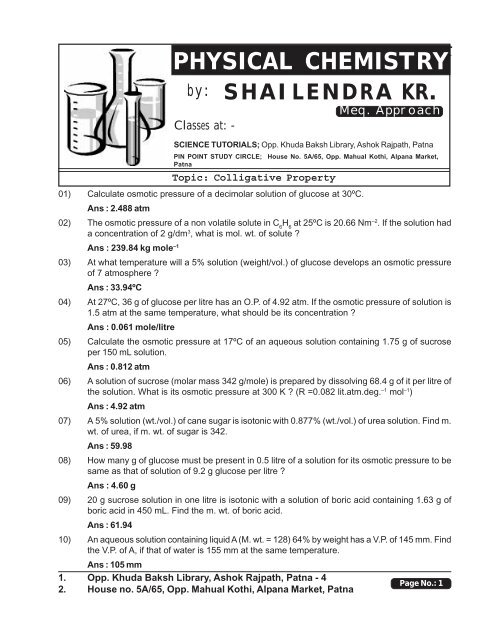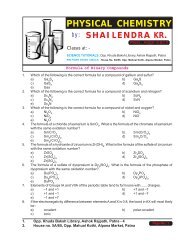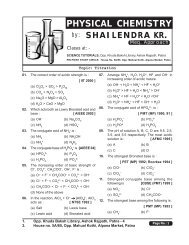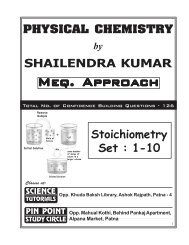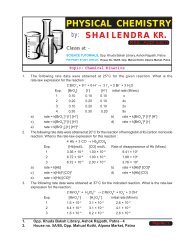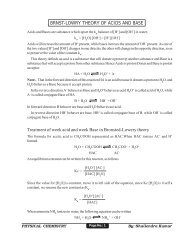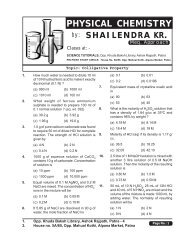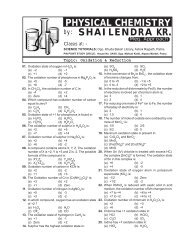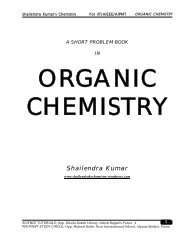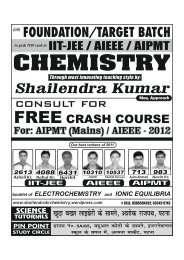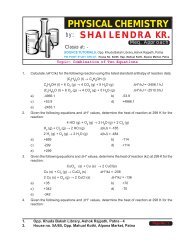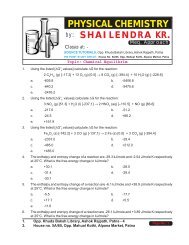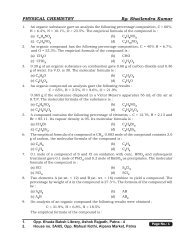Colligative Property (Assignment) - Shailendra Kumar Chemistry
Colligative Property (Assignment) - Shailendra Kumar Chemistry
Colligative Property (Assignment) - Shailendra Kumar Chemistry
Create successful ePaper yourself
Turn your PDF publications into a flip-book with our unique Google optimized e-Paper software.
PHYSICAL CHEMISTRY<br />
Ans : 105 mm<br />
1. Opp. Khuda Baksh Library, Ashok Rajpath, Patna - 4<br />
2. House no. 5A/65, Opp. Mahual Kothi, Alpana Market, Patna<br />
By: <strong>Shailendra</strong> <strong>Kumar</strong><br />
PHYSICAL CHEMISTRY<br />
by: SHAILENDRA KR.<br />
Classes at: -<br />
Meq. Approach<br />
SCIENCE TUTORIALS; Opp. Khuda Baksh Library, Ashok Rajpath, Patna<br />
PIN POINT STUDY CIRCLE; House No. 5A/65, Opp. Mahual Kothi, Alpana Market,<br />
Patna<br />
Topic: <strong>Colligative</strong> <strong>Property</strong><br />
01) Calculate osmotic pressure of a decimolar solution of glucose at 30ºC.<br />
Ans : 2.488 atm<br />
02) The osmotic pressure of a non volatile solute in C 6<br />
H 6<br />
at 25ºC is 20.66 Nm –2 . If the solution had<br />
a concentration of 2 g/dm 3 , what is mol. wt. of solute <br />
Ans : 239.84 kg mole –1<br />
03) At what temperature will a 5% solution (weight/vol.) of glucose develops an osmotic pressure<br />
of 7 atmosphere <br />
Ans : 33.94ºC<br />
04) At 27ºC, 36 g of glucose per litre has an O.P. of 4.92 atm. If the osmotic pressure of solution is<br />
1.5 atm at the same temperature, what should be its concentration <br />
Ans : 0.061 mole/litre<br />
05) Calculate the osmotic pressure at 17ºC of an aqueous solution containing 1.75 g of sucrose<br />
per 150 mL solution.<br />
Ans : 0.812 atm<br />
06) A solution of sucrose (molar mass 342 g/mole) is prepared by dissolving 68.4 g of it per litre of<br />
the solution. What is its osmotic pressure at 300 K (R =0.082 lit.atm.deg. –1 mol –1 )<br />
Ans : 4.92 atm<br />
07) A 5% solution (wt./vol.) of cane sugar is isotonic with 0.877% (wt./vol.) of urea solution. Find m.<br />
wt. of urea, if m. wt. of sugar is 342.<br />
Ans : 59.98<br />
08) How many g of glucose must be present in 0.5 litre of a solution for its osmotic pressure to be<br />
same as that of solution of 9.2 g glucose per litre <br />
Ans : 4.60 g<br />
09) 20 g sucrose solution in one litre is isotonic with a solution of boric acid containing 1.63 g of<br />
boric acid in 450 mL. Find the m. wt. of boric acid.<br />
Ans : 61.94<br />
10) An aqueous solution containing liquid A (M. wt. = 128) 64% by weight has a V.P. of 145 mm. Find<br />
the V.P. of A, if that of water is 155 mm at the same temperature.<br />
Page No.: 1
PHYSICAL CHEMISTRY<br />
Ans : A : 80 mm & B: 114.117 mm<br />
1. Opp. Khuda Baksh Library, Ashok Rajpath, Patna - 4<br />
2. House no. 5A/65, Opp. Mahual Kothi, Alpana Market, Patna<br />
By: <strong>Shailendra</strong> <strong>Kumar</strong><br />
11) A mixture of ethyl alcohol and propyl alcohol has a V.P. of 290 mm at 27ºC. If mole fraction of<br />
ethyl alcohol is 0.65, calculate the vapour pressure of ethyl alcohol, if vapour pressure of propyl<br />
alcohol is 210 mm.<br />
Ans : 333.1 mm<br />
12) At 300 K, the vapour pressure of an ideal solution containing one mole of A and 3 moles of B is<br />
550 mm Hg. At the same temperature, if one mole of B is added to this solution, the vapour<br />
pressure of solution increases by 10mm of Hg. Calculate the V.P. of A and B in their pure state<br />
Ans : 400 mm & 600 mm<br />
13) Cyclohexane and ethanol at a particular temperature have vapour pressure of 280 mm and 168<br />
mm respectively. If these two solutions having mole fraction value of cyclohexane equal to 0.32<br />
are mixed and the mixture has a total vapour pressure of 376 mm, will the mixture be an ideal<br />
solution <br />
Ans : 203.84 mm (Solution is not ideal)<br />
14) Vapour pressure of C 6<br />
H 6<br />
and C 7<br />
H 8<br />
mixture at 50ºC are given by P = 179XB + 92, where XB is<br />
mole fraction of C 6<br />
H 6<br />
. Calculate (in mm):<br />
(a) Vapour pressure of pure liquids.<br />
(b) Vapour pressure of liquid mixture obtained by mixing 936 g C 6<br />
H 6<br />
and 736 g toluene.<br />
(c) If the vapours are removed and condensed into liquid and again brought to the temperature<br />
of 50ºC, what would be mole fraction of C 6<br />
H 6<br />
in vapour state <br />
Ans : (a) V.P of pure C 6<br />
H 6<br />
= 271 mm, V.P of pure C 7<br />
H 8<br />
= 92 mm<br />
(b) 199.4 mm<br />
(c) XC 6<br />
H 6<br />
in vapour state = 0.928, XC 7<br />
H 8<br />
in vapour state = 0.072<br />
15) 10 g of a certain non-volatile solute were dissolved in 100 g water at 20ºC. The vapour pressure<br />
was lowered from 17.3555 mm to 17.2350 mm, calculate M. wt. of solute.<br />
Ans : 257.45<br />
16) Calculate vapour pressure of a solution at 100ºC having 3.42 g of cane sugar in 180 g water.<br />
Ans : 759.2 mm<br />
17) The vapour pressure of water at 20ºC is 17.54 mm. When 20 g of solute was added in 100 g<br />
water, the V.P. was found to lower by 0.30 mm. Calculate M. wt. of solute.<br />
Ans : 206.88<br />
18) Find the molality of a solution containing a non-volatile solute if the vapour pressure is 2% below<br />
the vapour pressure of pure water.<br />
Ans : 1.133<br />
19) Calculate the relative lowering in V.P. if 10 g of a solute (m. wt. 100) are dissolved in 180 g water.<br />
Ans : 0.0099<br />
20) Benzene and toluene form two ideal solutions A and B at 313 K. Solution A contains 4 moles of<br />
toluene and one mole of C 6<br />
H 6<br />
. Solution B contains equal masses of toluene and benzene.<br />
Calculate total pressure in each case. The vapour pressure of C 6<br />
H 6<br />
and toluene are 160 and 60<br />
mm respectively at 313 K.<br />
Page No.: 2
PHYSICAL CHEMISTRY<br />
By: <strong>Shailendra</strong> <strong>Kumar</strong><br />
21) What weight of non volatile solute, urea (NH 2<br />
CONH 2<br />
) needs to be dissolved in 100 g of water, in<br />
order to decrease the vapour pressure of water by 25%. What will be the molality of solution <br />
Ans : 18.52 m<br />
22) An aqueous solution of glucose containing 12 g in 100 g of water was found to boil at 100.34ºC.<br />
Calculate Kb for water in K mole –1 kg.<br />
Ans : 0.51 K mole –1 kg<br />
23) What will be the boiling point of bromine when 174.5 mg of octa atomic sulphur is added to<br />
78 g of bromine. K’b for Br 2<br />
is 5.2 K mole –1 kg and b. pt. of Br 2<br />
is 332.15 K.<br />
Ans : 332.195 K<br />
24) At 90ºC, the vapour pressure of toluene is 400 mm and that of xylene is 150 mm. What is the<br />
composition of liquid mixture that will boil at 90ºC when the pressure of mixture is 0.5 atm <br />
Ans : XToluene = 0.92, XXylene = 0.08<br />
25) An aqueous solution of glucose boils at 100.01ºC. The molal elevation constant for water is<br />
0.5 K mole –1 kg. What is the number of glucose molecules in the solution containing 100 g<br />
water.<br />
Ans : 1.2 × 10 21 molecules<br />
26) The molal freezing point constant of C 6<br />
H 6<br />
is 4.90 and its melting point is 5.51ºC. A solution of<br />
0.816 g of a compound A dissolved in 7.5 g of benzene freezes at 1.59ºC. Calculate molecular<br />
weight of compound A.<br />
Ans : 136<br />
27) Two solutions containing respectively 0.75 g of urea (m. wt. 60) and 1.5 g of compound A in<br />
100 g water, freeze at the same temperature. Calculate molecular weight of A.<br />
Ans : 120<br />
28) What weight of glycerol would have to be added in 1000 g of water in order to lower its freezing<br />
point by 10ºC K f<br />
for water is 1.86 K mole –1 kg.<br />
Ans : 494.6 g<br />
29) An aqueous solution containing 5% by weight of urea and 10% by weight of glucose. What will<br />
be its freezing point K’ f<br />
for H 2<br />
O is 1.86º mole –1 kg.<br />
Ans : –3.04ºC<br />
30) Calculate the depression in freezing point caused by the addition of 0.5309 g of solid (m.wt.30.63)<br />
in 40 g water. The molal depression constant is 1.85º mole –1 kg.<br />
Ans : 0.802º<br />
31) A solution of 0.643 g of an organic compound in 50 mL of benzene (density 0.879 g/mL) lowered<br />
its freezing point from 5.51ºC to 5.03ºC. Calculate the molecular weight of solid. K f<br />
for benzene<br />
is 5.12 K mole –1 kg.<br />
Ans : 156.06<br />
32) Calculate the amount of ice that will separate out on cooling a solution containing 50 g of<br />
ethylene glycol in 200 g water to –9.3ºC. (K f<br />
for water = 1.86 K mole –1 kg)<br />
Ans : 38.71 g<br />
1. Opp. Khuda Baksh Library, Ashok Rajpath, Patna - 4<br />
2. House no. 5A/65, Opp. Mahual Kothi, Alpana Market, Patna<br />
Page No.: 3
PHYSICAL CHEMISTRY<br />
By: <strong>Shailendra</strong> <strong>Kumar</strong><br />
33) An aqueous solution was found to have an osmotic pressure of 2.51 atm at 25ºC. What will be<br />
the freezing point of solution if K’ f<br />
for water is 1.86 K mole –1 kg Assume molarity and molality<br />
are same.<br />
Ans : 0.19ºC<br />
34) Calculate the freezing point of an aqueous solution of non electrolyte having an osmotic pressure<br />
2.0 atm at 300 K. K’ f<br />
= 1.86 K mole –1 kg and S = 0.0821 litre atm K –1 mole –1 .<br />
Ans : 0.151ºC<br />
35) A decimolar solution of potassium ferrocyanide is 50% dissociated at 300 K. Calculate osmotic<br />
pressure of the solution. Given S = 8.314 JK –1 mole –1 .<br />
Ans : 7.842 × 10 5 Nm –2<br />
36) A 1% (wt./vol.) KCl solution is ionised to the extent of 82%. What would be its osmotic pressure<br />
at 18ºC <br />
Ans : 5.842 atm<br />
37) 7.6 g KBr in 1250 mL solution was found to have an osmotic pressure of 1.804 atm at 27ºC.<br />
Calculate degree of ionisation and vant Hoff factor.<br />
Ans : α = 43.4%, i = 1.434<br />
38) Calculate the osmotic pressure of 20% (wt./vol.) anhydrous CaCl 2<br />
solution at 0ºC assuming<br />
100% ionisation.<br />
Ans : 121.14 atm<br />
39) A certain mass of a substance when dissolved in 100 g C 6<br />
H 6<br />
lowers the freezing point by<br />
1.28ºC. The same mass of solute dissolved in 100 g of water lowers the freezing point by<br />
1.40ºC. If the substance has normal molecular weight in benzene and is completely dissociated<br />
in water, into how many ions does it dissociate in water K f<br />
for H 2<br />
O and C 6<br />
H 6<br />
are 1.86 and<br />
5.12 K mole –1 kg respectively.<br />
Ans : Number of ions given = 3<br />
40) Calculate osmotic pressure of a decinormal solution of BaCl 2<br />
at 27ºC showing 80% degree of<br />
ionisation.<br />
Ans : 3.20 atm<br />
41) A 1.2 % solution (wt./volume) of NaCl is isotonic with 7.2% solution (wt./volume) of glucose.<br />
Calculate degree of ionisation and vant Hoff factor of NaCl.<br />
Ans : i = 1.95, α = 0.95<br />
42) The vapour pressure of a solution containing 2 g of an electrolyte BA in 100 g water, which<br />
dissociates in one B + and one A – ion in water, is 751 mm, at 100ºC. Calculate degree of ionisation<br />
of BA if its mol.wt. is 56.<br />
Ans : α = 0.8641<br />
43) When 11.7 g of NaCl are dissolved in 200 g of water the depression in freezing point is doubled<br />
than the depression caused by 342 g of cane sugar in 1000 g of water. From this information<br />
what do you infer about the nature of solute particles of NaCl in solution.<br />
Ans : α = 1, That is NaCl is 100% ionised in solution<br />
1. Opp. Khuda Baksh Library, Ashok Rajpath, Patna - 4<br />
2. House no. 5A/65, Opp. Mahual Kothi, Alpana Market, Patna<br />
Page No.: 4
PHYSICAL CHEMISTRY<br />
By: <strong>Shailendra</strong> <strong>Kumar</strong><br />
44) A storage battery contains a solution of H 2<br />
SO 4<br />
38% by weight. At this concentration, vant Hoff<br />
factor is 2.50. At what temperature will the battery contents freeze <br />
Ans : 243.92 K<br />
45) Calculate the boiling point of a solution containing 0.61 g of benzoic acid in 50 g of carbon<br />
disulphide assuming 84% dimeization of the acid. The boiling point and Kb of CS 2<br />
are 46.2ºC<br />
and 2.3 K Kg mole –1 .<br />
Ans : 46.33 ºC<br />
46) The degree of dissociation of Ca(NO 3<br />
) 2<br />
in a dilute aqueous solution containing 7 g of salt per<br />
100 g of water at 100ºC is 70%. Calculate the vapour pressure of solution.<br />
Ans : 746.26 mm<br />
47) 1 g of mono basic acid in 100 g of water lowers the freezing point by 0.168º. If 0.2 g of same<br />
acid requires 15.1 mL of N/10 alkali for complete neutralization, calculate degree of dissociation<br />
of acid K’ f<br />
for H 2<br />
O is 1.86 K mole –1 kg.<br />
Ans : 19.6%<br />
48) The freezing point of a solution containing 0.2 g of acetic acid in 20.0 g benzene is lowered by<br />
0.45ºC. Calculate the degree of association of acetic acid in benzene. Assume acetic acid<br />
dimerizes in benzene K f<br />
for benzene = 5.12 K mole –1 kg.<br />
Ans : α = 0.945 or 94.5%<br />
49) 2 g of benzoic acid dissolved in 25 g if C 6<br />
H 6<br />
shows a depression in freezing point equal to<br />
1.62K. Molal depression constant of C 6<br />
H 6<br />
is 4.9 K mole –1 kg. What is the percentage association<br />
of acid if it forms double molecule in solution.<br />
Ans : α = 0.992 or 99.2%<br />
50) Phenol associates in benzene to a certain extent to form a dimer. A solution containing<br />
20 × 10 –3 kg of phenol in 1.0 kg of benzene has its f.pt. depressed by 0.69 K. Calculate the<br />
fraction of phenol dimerzed. K’ f<br />
for C 6<br />
H 6<br />
= 5.12º mole –1 kg.<br />
Ans : α = 0.734, 73.4%<br />
51) A solution containing 28 g phosphorus in 315 g CS 2<br />
(b.pt. 46.3ºC) boils at 47.98ºC. K’ b<br />
for CS 2<br />
is 2.34 K mole –1 kg. Calculate m. wt. of phosphorus and deduce its molecular formula. Assume<br />
its complete association.<br />
Ans : P 4<br />
52) A 0.025 M solution of monobasic acid had a freezing point of –0.06ºC. Calculate Kα for the acid.<br />
K f<br />
H 2<br />
O = 1.86º molality –1 . Assume molality equal to molarity.<br />
Ans : 2.96 × 10 –3<br />
53) Calculate the molal lowering of vapour pressure for H 2<br />
O at 100ºC.<br />
Ans : 13.43 mm<br />
54) 100 g of sucrose solution in water is cooled to –0.5ºC. What weight of ice would be separated<br />
out at this temperature, if solution started to freeze at –0.38ºC K’ f<br />
for H 2<br />
O = 1.86 K mole –1 kg.<br />
Ans : 21.62 g<br />
1. Opp. Khuda Baksh Library, Ashok Rajpath, Patna - 4<br />
2. House no. 5A/65, Opp. Mahual Kothi, Alpana Market, Patna<br />
Page No.: 5
PHYSICAL CHEMISTRY<br />
1. Opp. Khuda Baksh Library, Ashok Rajpath, Patna - 4<br />
2. House no. 5A/65, Opp. Mahual Kothi, Alpana Market, Patna<br />
By: <strong>Shailendra</strong> <strong>Kumar</strong><br />
55) At 40ºC the vapour pressure, in torr, of methyl alcohol-ethyl alcohol solutions is represented by<br />
P = 119x + 135; Where x is the mole fraction of methyl alcohol. What are the vapour pressure<br />
of the pure components at this temperature <br />
Ans : 254 torr, 135 torr<br />
56) Ethylene bromide, C 2<br />
H 4<br />
Br 2<br />
, and 1,2 -dibromopropane, C 3<br />
H 6<br />
Br 2<br />
, form a series of ideal solutions<br />
over the whole range of composition. At 85ºC the vapour pressure of these two pure liquids are<br />
173 and 127 torr, respectively. (a) If 10.0 g of ethylene bromide is dissolved in 80.0 g of<br />
1,2-dibromopropane, calculate the partial pressure of each component and the total pressure<br />
of the solution at 85ºC. (b) Calculate the mole fraction of ethylene bromide in the vapour in<br />
equilibrium with the above solution. (c) What would be the mole fraction of ethylene bromide in<br />
a solution at 85ºC equilibrated with a 50:50 mole mixture in the vapour<br />
Ans : (a) 132 torr (b) 0.155 (c) 0.423<br />
57) The vapour pressure of pure liquid solvent A is 0.80 atm. When a nonvolatile substance B is<br />
added to the solvent, its vapour pressure drops to 0.60 atm. What is the mole fraction of<br />
component B in the solution <br />
Ans : 0.25<br />
58) The vapour pressure of pure water at 26ºC is 25.21 torr. What is the vapour pressure of a<br />
solution which contains 20.0 g glucose, C 6<br />
H 12<br />
O 6<br />
, in 70 g water <br />
Ans : 24.5 torr<br />
59) The vapour pressure of pure water at 25ºC is 23.76 torr. The vapour pressure of a solution<br />
containing 5.40 g of a nonvolatile substance in 90.0 g water is 23.32 torr. Compute the molecular<br />
weight of the solute.<br />
Ans : 55.8 g/mole<br />
60) At 30ºC, pure benzene ( molecular weight 78.1 g/mol) has a vapour pressure of 121.8 torr.<br />
Dissolving 15.0 g of a nonvolatile solute in 250 g of benzene produced a solution having a<br />
vapour pressure of 120.2 torr. Determine the approximate molecular weight of the solute.<br />
Ans : 350<br />
61) The vapour pressure of water at 28ºC is 28.35 torr. Compute the vapour pressure at 28ºC of a<br />
solution containing 68 g of cane sugar, C 12<br />
H 22<br />
O 11<br />
, in 1000 g of water.<br />
Ans : 28.25 torr<br />
62) Calculate the mole fraction of toluene in the vapour phase which is in equilibrium with a solution<br />
of benzene and toluene having a mole fraction of toluene 0.500. The vapour pressure of pure<br />
benzene is 119 torr, that of toluene is 37.0 torr at the same temperature.<br />
Ans : 0.237<br />
63) What is the composition of the vapour which is in equilibrium at 30ºC with a benzene-toluene<br />
solution with a mole fraction of benzene of 0.400 with a mole fraction of benzene of 0.6000<br />
o<br />
o<br />
P<br />
b<br />
= 119 torr and P = 37.0 torr<br />
t<br />
Ans : X b<br />
= 0.829, X t<br />
= 0.171<br />
64) At 50ºC tha vapour pressure of pure CS 2<br />
is 854 torr. A solution of 2.0 g of sulfur in 100 g of CS 2<br />
has a vapour pressure 848.9 torr. Determine the formula of the sulfur molecule.<br />
Ans : 8<br />
Page No.: 6
PHYSICAL CHEMISTRY<br />
Ans : (a) 0.186ºC (b) 0.512ºC<br />
1. Opp. Khuda Baksh Library, Ashok Rajpath, Patna - 4<br />
2. House no. 5A/65, Opp. Mahual Kothi, Alpana Market, Patna<br />
By: <strong>Shailendra</strong> <strong>Kumar</strong><br />
65) Calculate the vapour pressure lowering of a 0.100 m aqueous solution of nonelectrolyte at<br />
75ºC.<br />
Ans : 0.533 torr<br />
66) Calculate the composition of the vapour in equilibrium with an ideal solution of ethylbenzene<br />
o<br />
o<br />
(P = 10.0 torr) and methylbenzene (P = 37.0 torr) in which the mole fraction of ethylbenzene in<br />
e<br />
m<br />
the liquid is 0.35. Calculate the total vapour pressure of the solution.<br />
Ans : 28 torr<br />
67) The vapour pressure of pure benzene, C 6<br />
H 6<br />
, at 50ºC is 268 torr. How many mole of nonvoltile<br />
solute per mole of benzene is required to prepare a solution of benzene having a vapour pressure<br />
of 167.0 torr at 50ºC <br />
Ans: 0.605 mole solute/mole benzene<br />
68) At 25ºC, the vapour pressure of methyl alcohol, CH 3<br />
OH is 96.0 torr. What is the mole fraction of<br />
CH 3<br />
OH in a solution in which the (partial) vapour pressure of CH 3<br />
OH is 23.0 torr at 25ºC <br />
Ans : 0.240<br />
69) At 25ºC, the vapour pressure of pure benzene is 100 torr, while that of pure ethyl alcohol is 44<br />
torr. Assuming ideal behavior, calculate the vapour pressure at 25ºC of a solution which contains<br />
10.0 g of each substance.<br />
Ans : 65 torr<br />
70) Estimate the lowering of the vapour pressure due to the solute in a 1.0 m aqueous solution at<br />
100ºC.<br />
Ans : 14 torr<br />
71) When 10.6 g of nonvolatile substance is dissolved in 740 g of ether, its boiling point is raised<br />
0.284ºC. What is the molecular weight of the substance Molar boiling point constant for ether<br />
is 2.11ºC kg/mole.<br />
Ans : 106 g/mole<br />
72) The freezing point of a sample of naphthalene was found to be 80.6ºC. When 0.512 g of a<br />
substance is dissolved in 7.03 g maphthalene, the solution has a freezing point of 75.2ºC. What<br />
is the molecular weight of the solute The molal freezing point constant of naphthalene is<br />
6.80ºC kg/mole.<br />
Ans : 92 g/mole<br />
73) The freezing point of a solution containing 2.40 g of a compound in 60.0 g of benzene is 0.10ºC<br />
lower than that of pure benzene. What is the molecular weight of the compound (K f<br />
is<br />
5.12ºC/m for benzene.)<br />
Ans : 2050 g/mole<br />
74) An aqueous solution containing 288 g of a nonvolatile compound having the stoichiometric<br />
composition C n<br />
H 2n<br />
O n<br />
in 90.0 g of water boils at 101.24ºC at 1.00 atm pressure. What is the<br />
molecular formula of the compound <br />
Ans : C 44<br />
H 88<br />
O 44<br />
75) Calculate (a) the freezing point of a solution of 0.0100 mole of glucose dissolved in 100 g of<br />
water, and (b) the freezing point of a 0.100 m solution of naphthalene in benzene.<br />
Page No.: 7
PHYSICAL CHEMISTRY<br />
By: <strong>Shailendra</strong> <strong>Kumar</strong><br />
76) A solution containing 3.50 g of solute X in 50.0 g of water has a volume of 52.5 mL and a<br />
freezing point of –0.86ºC. (a) Calculate the molality, mole freaction, and molarity of X. (b)<br />
Calculate the molecular weight of X.<br />
Ans : (a) 0.46 m<br />
(b) 152 g/mole<br />
77) When 36.0 g of a solute having the empirical formula CH 2<br />
O is dissolved in 1.20 kg of water, the<br />
solution freezing at –0.93ºC. What is the molecular formula of the solute <br />
Ans : C 2<br />
H 4<br />
O 2<br />
78) Calculate the freezing point of 0.200 m solutions of fructose, C 6<br />
H 12<br />
O 6<br />
. (a) in water (b) in acetic<br />
acid<br />
Ans : (a) 0.372ºC (b) 0.78ºC<br />
79) A solution of 10.0 g of a nonionic solute in 100 g of benzene freezs at 4.2ºC. Calculate the<br />
molecular weight of the solute.<br />
Ans : 400 g/mole<br />
80) A solution containing 6.35 g of a nonelectolyte dissolved in 500 g of water freezes at –0.465ºC.<br />
Determine the molecular weight of the solute.<br />
Ans : 64.0 g/mole<br />
81) A solution containing 3.24 g of a nonvolatile nonelectrolyte and 200 g of water boils at 100.130ºC<br />
at 1 atm. What is the molecular weight of the solute <br />
Ans : 64.0 g/mole<br />
82) Calculate the freezing point and the boiling point at at 1 atm of a solution containing 30.0 g cane<br />
sugar (molecular weight 342 g/mol) and 150 g water.<br />
Ans : –1.09ºC, 100.300ºC<br />
83) A solution was made up by dissolving 3.75 g of a pure hydrocarbon in 95.0 g of acetone. The<br />
boiling point of pure acetone was observed to be 55.95ºC, and of the solution, 56.50ºC. If the<br />
molal boiling point constant of acetone is 1.71 ºC kg/mole, what is the approximate molecular<br />
weight of the hydrocarbon <br />
Ans : 123 g/mole<br />
84) The molecular weight of an organic compound is 58.0 g/mol. Compute the boiling point of a<br />
solution containing 24.0 g of the solute and 600 g of water, when the barometric pressure is<br />
such that pure water boils at 99.725ºC.<br />
Ans : 100.079ºC<br />
85) A certain solution of benzoic acid in benzene has a freezing point of 3.1ºC and a normal boiling<br />
point of 82.6ºC. Explain these observations, and suggest structures for the solute particles at<br />
the two temperatures.<br />
Ans : Do yourself<br />
86) The osmotic pressure of blood is 7.65 atm at 37ºC. How much glucose should be used per L<br />
for an intravenous injection that is to have the same osmotic pressure as blood <br />
Ans : 54.2 g<br />
1. Opp. Khuda Baksh Library, Ashok Rajpath, Patna - 4<br />
2. House no. 5A/65, Opp. Mahual Kothi, Alpana Market, Patna<br />
Page No.: 8
PHYSICAL CHEMISTRY<br />
1. Opp. Khuda Baksh Library, Ashok Rajpath, Patna - 4<br />
2. House no. 5A/65, Opp. Mahual Kothi, Alpana Market, Patna<br />
By: <strong>Shailendra</strong> <strong>Kumar</strong><br />
87) A aqueous solution of urea had a freezing point of –0.52ºC. Predict the osmotic pressure of the<br />
same solution at 37ºC. Assume that the molar concentration and the molality are numerically<br />
equal.<br />
Ans : 7.1 atm<br />
88) The osmotic pressure of a solution of a synthetic polyisobutylene in benzene was determined<br />
at 25ºC. A sample containing 0.20 g of solute/100 cm 3 of solution developed a rise of 2.4 mm at<br />
osmotic equilibrium. The density of the solution was 0.88 g/cm 3 . What is the molecular weight<br />
of the polyyisobutylene <br />
Ans : 2.4 × 10 5 g/mole<br />
89) What would be the osmotic pressure at 17 ºC of an aqueous solution containing 1.75 g of<br />
sucrose (C 12<br />
H 22<br />
O 11<br />
) per 150 cm 3 solution <br />
Ans : 0.81 atm<br />
90) Calculate the osmotic pressure of a 0.100 M solution of a nonelectrolyte at 0ºC.<br />
Ans : 2.24 atm<br />
91) What is the molecular weight, MA, of a solute, A, if the osmotic pressure of a solution containing<br />
10.0 g/L is 10.0 torr at 27ºC <br />
Ans : 18700 g/mole<br />
92) A 250-mL water solution containing 48.0 g of sucrose, C 12<br />
H 22<br />
O 11<br />
, at 300 K is separated from<br />
pure water by means of a semipermeable membrane. What pressure must be applied above<br />
the solution in order to just prevent osmosis <br />
Ans : 13.8 atm<br />
93) Calculate the osmotic pressure of an aqueous solution which contains 4.00 g of glucose, C 6<br />
H 12<br />
O 6<br />
,<br />
in 250 mL of solution at 25ºC.<br />
Ans : 2.17 atm<br />
94) A solution of crab hemocyanin, a pigmented protein extracted from crabs, was prepared by<br />
dissolving 0.750 g in 125 cm 3 of an aqueous medium. At 4ºC an osmotic pressure rise of<br />
2.6 mm of the solution was observed. The solution had a density of 1.00 g/cm 3 . Determine the<br />
molecular weight of the protein.<br />
Ans : 5.4 × 10 5 g/mole<br />
95) The solubility of N 2<br />
in water is 2.2 × 10 –4 g in 100 g of H 2<br />
O at 20ºC when the pressure of nitrogen<br />
over the solution is 1.2 atm. Calculate the solubility at that temperature when the nitrogen<br />
pressure is 10 atm.<br />
Ans : 1.8 mg<br />
96) Of the following 1.10 m aqueous solution, which one will exhibit the largest freezing point<br />
depression <br />
Ans : (a) KCl (b) C 6<br />
H 12<br />
O 6<br />
(c) K 2<br />
SO 4<br />
(d) Al 2<br />
(SO 4<br />
) 3<br />
(e) NaCl<br />
97) Arrange the following aqueous solution in order of increasing freezing points (that is, lowest<br />
first): (a) 0.10 m C 2<br />
H 5<br />
OH (b) 0.10 m Ba 3<br />
(PO 4<br />
) 2<br />
(c) 0.10 m Na 2<br />
SO 4<br />
(d) 0.10 m KCl<br />
(e) 0.10 m Li 3<br />
PO 4<br />
.<br />
Ans : b < e < c < d < a<br />
Page No.: 9
PHYSICAL CHEMISTRY<br />
By: <strong>Shailendra</strong> <strong>Kumar</strong><br />
98) Chloroacetic acid, a monoprotic acid has a K a<br />
of 1.36 × 10–3. Compute the freezing point of a<br />
0.10 M solution of this acid. Assume that the stoichiometeic molar concentration and molality<br />
are the same in this case.<br />
Ans : –0.21ºC<br />
99) A 0.025 M solution of monobasic acid had a freezing point of –0.060ºC. What are K a<br />
and PK a<br />
for<br />
the acid <br />
Ans : K a<br />
= 3 × 10 –3 , PK a<br />
= 2.5<br />
100) A 0.100 M solution of an acid (density = 1.010 g/cm 3 ) is 4.5% ionized. Compute the freezing<br />
point of the solution. The molecular weight of the acid is 300.<br />
Ans : –0.199ºC<br />
101) How many grams of H 2<br />
O must be used to dissolved 50.0 grams of sucrose to prepare a 1.25m<br />
solution of sucrose, C 12<br />
H 22<br />
O 11<br />
<br />
Ans : 117 g H 2<br />
O<br />
102) What are the mole fractions of CH 3<br />
OH and H 2<br />
O in the solution containing 128 g CH 3<br />
OH and<br />
108 g H 2<br />
O.<br />
Ans : XCH 3<br />
OH = 0.400, XH 2<br />
O = 0.600<br />
103) Sucrose is a nonvolatile, nonionizing solute in water. Determine the vapour pressure lowering,<br />
at 25ºC, of the 1.25 m sucrose solution in Question No.101. Assume that the solution behaves<br />
ideally. The vapour of pure water at 25ºC is 23.8 torr.<br />
Ans : 0.52 torr<br />
104) At 40ºC, the vapour pressure of pure n-heptane is 92.0 torr and the vapour pressure of pure<br />
n-octane is 31.0 torr. Consider a solution that contains 1.00 mole of n-heptane and 4.00 moles<br />
of n-octane. Calculate the vapour pressure of each component and the total vapour pressure<br />
above the solution.<br />
Ans : 18.4 torr<br />
105) Calculate the mole fractions of n-heptane and n-octane in the vapour that is in equilibrium with<br />
the solution in Question No.104.<br />
Ans : X n-heptane<br />
= 0.426, X n-octane<br />
= 0.574<br />
106) What is the normal boiling point of the 1.25 m sucrose solution of Question No.101.<br />
Ans : 100.640ºC<br />
107) When 15.0 grams of ethyl alcohol, C 2<br />
H 5<br />
OH, is dissolved in 750 grams of formic acid, the<br />
freezing point of the solution is 7.20ºC. The freezing point of pure formic acid is 8.40ºC. Evaluated<br />
K f<br />
for formic acid.<br />
Ans : 2.76ºC/m<br />
108) What is the freezing point of the 1.25 m sucrose solution of Question No.101.<br />
Ans : –2.32ºC<br />
109) A 1.20-gram sample of an unknown covalent compound is dissolved in 50.0 grams of benzene.<br />
The solution freezes at 4.92ºC. Determine the molecular weight of the compound.<br />
Ans : 2.2 × 10 2 amu<br />
1. Opp. Khuda Baksh Library, Ashok Rajpath, Patna - 4<br />
2. House no. 5A/65, Opp. Mahual Kothi, Alpana Market, Patna<br />
Page No.: 10
PHYSICAL CHEMISTRY<br />
By: <strong>Shailendra</strong> <strong>Kumar</strong><br />
110) Either camphor (C 10<br />
H 16<br />
O, molecular weight = 152.24 g/mol) or naphthalene (C 10<br />
H 8<br />
, molecular<br />
weight 128.19 g/mol) can be used to make mothballs. A 5.0-gram sample of mothballs was<br />
dissolved in 100.0 grams of ethyl alcohol, and the resulting solution had a boiling point of 78.90ºC.<br />
Determine whether the mothballs were made of camphor or naphthalene. Pure ethyl alcohol<br />
has a boiling point of 78.41ºC, and K b<br />
= 1.22ºC/m for this solvent.<br />
Ans : Molucular weight of solute after calculation is around 125. Hence solute is<br />
nepthalene<br />
111) Lactic acid, C 2<br />
H 4<br />
(OH)(COOH), is found in sour milk. It is also formed in muscles during intense<br />
physical activity and is responsible for the pain felt during strenuous exercise. It is a weak<br />
monoprotic acid and therefore a weak electolyte. The freezing point of a 0.0100 m aqueous<br />
solution of lactic acid is –0.0206ºC. Calculate (a) the i value and (b) the percent ionization in the<br />
solution.<br />
Ans : (a) 0.11(b) 11%<br />
112) What osmotic pressure would the 1.25 m sucrose solution of Question No. 101 exhibit at<br />
25ºC The density of this solution is 1.34 g/mL.<br />
Ans : 28.6 atm<br />
113) Pepsin is an enzyme present in the human digestive tract. An enzyme is a protein that acts as<br />
a biological catalyst. Pepsin catalyzes the metabolic cleavage of amino acid chains (called<br />
peptide chains) in other proteins. A solution of a 0.500-gram sample of purified pepsin in 30.0<br />
mL of benzene solution exhibits an osmotic pressure of 8.92 torr at 27ºC. Estimate the molecular<br />
weight of pepsin.<br />
Ans : 3.50 × 10 4 g/mole<br />
114) The solubility of K 2<br />
ZrF 6<br />
at 100ºC in 100 g of H 2<br />
O is 25 g. Express this concentration in terms of<br />
(a) molality and (b) mole fraction.<br />
Ans : (a) 0.88 m K 2<br />
ZrF 6<br />
(b) 0.016<br />
115) A solution that is 24.0% fructose, C 6<br />
H 12<br />
O 6<br />
, in water has a density of 1.10 g/mL at 20ºC.<br />
(a) What is the molality of fructose in this solution (b) At a higher temperature, the density<br />
would be lower. Would the molality be less than, greater than, or the same as the molality at<br />
20ºC <br />
Ans : (a) 1.75 m C 6<br />
H 12<br />
O 6<br />
(b) The same<br />
116) The density of an aqueous solution containing 10.00 g K 2<br />
SO 4<br />
in 100.00 g solution is 1.0825<br />
g/mL. Calculate the concentration of this solution in molarity, molality, percent of K 2<br />
SO 4<br />
, and<br />
mole fraction of solvent.<br />
Ans : 0.6210 M K 2<br />
SO 4<br />
, 0.6374 m K 2<br />
SO 4<br />
, 10.00% K 2<br />
SO 4<br />
, 0.9886<br />
117) Calculate (a) the lowering of vapour pressure and (b) the vapour pressure of a solution<br />
prepared by dissolving 50.0 g of naphthalene, C 10<br />
H 8<br />
, (a nonvolatile nonelectrolyte), in 150.0g of<br />
benzene, C 6<br />
H 6<br />
, at 20ºC. Assume that the solution is ideal. The vapour pressure of pure benzene<br />
is 74.6 torr at 20ºC.<br />
Ans : (a) 12.6 torr (b) 62.0 torr<br />
1. Opp. Khuda Baksh Library, Ashok Rajpath, Patna - 4<br />
2. House no. 5A/65, Opp. Mahual Kothi, Alpana Market, Patna<br />
Page No.: 11
PHYSICAL CHEMISTRY<br />
By: <strong>Shailendra</strong> <strong>Kumar</strong><br />
118) What mass of a nonvolatile solute having a molecular weight of 325 g/mol would be required to<br />
decrease the vapour pressure of 1.00 kg of water by 1.00 torr at 100ºC <br />
Ans : 23.9 g solute<br />
119) At – 100ºC the vapour pressure of pure ethane, CH 3<br />
CH 3<br />
, is 394 torr and that of pure propane,<br />
CH 3<br />
CH 2<br />
CH 3<br />
. is 22 torr. What is the vapour pressure over a solution containing equal molar<br />
amounts of these substances What is the composition of the vapour <br />
Ans : P total<br />
= 208 torr in the vapour , X ethane<br />
= 0.947, X propane<br />
= 0.053<br />
120) You have separate 0.10 M aqueous solutions of the following salts: LiNO 3<br />
, Ca(NO 3<br />
) 2<br />
,and<br />
Al(NO 3<br />
) 3<br />
. In which one would you expect the solute to be the most completely dissociated <br />
Which solution would you expect to conduct electricity most strongly <br />
Ans :<br />
121) What is the value of the van’t Hoff factor, i, for the following strong electrolytes at infinite dilution<br />
(a) Na 2<br />
SO 4<br />
, (b) KOH, (c) Al 2<br />
(SO 4<br />
) 3<br />
, (d) Ba(OH) 2<br />
.<br />
Ans : (a) 3 (b) 2 (c) 5 (d) 5<br />
122) Four beakers contain 0.010 m aqueous solution of CH 3<br />
OH, NaOH, CaCL 2<br />
, and CH 3<br />
COOH,<br />
respectively. Which of these solutions has the lowest freezing point <br />
Ans :<br />
123) One gram each of NaCl, NaBr, and NaI was dissolved in 100.0 g water. What is the vapour<br />
pressure above the solution at 100ºC Assume complete dissociation of the three salts.<br />
Ans : 751 torr<br />
124) A 0.100 m acetic acid solution in water freezes at –0.1884ºC. Calculate the precentage ionization<br />
of CH 3<br />
COOH in this solution.<br />
Ans : 1%<br />
125) CsCl dissolves in water according to<br />
CsCl Cs + + Cl –<br />
A 0.121 m solution of CsCl freezing at –0.403ºC. Calculate i and the apparent precentage<br />
dissociation of CsCl in this solution.<br />
Ans : i = 1.79, 79% ionization<br />
126) (a) Solution of benzoic acid, C 6<br />
H 5<br />
COOH, in nonpolar solvents such as benzene, C 6<br />
H 6<br />
, yield i<br />
values that approach ½ in freezing point depression experiments. How can you account for<br />
this (b) What is the apparent molecular weight of benzoic acid that would be determined by<br />
measuring the freezing point depression of a solution of benzene <br />
Ans : (a) Do yourself (b) 244 g/mole<br />
1. Opp. Khuda Baksh Library, Ashok Rajpath, Patna - 4<br />
2. House no. 5A/65, Opp. Mahual Kothi, Alpana Market, Patna<br />
Page No.: 12


